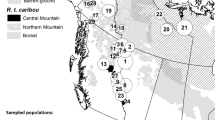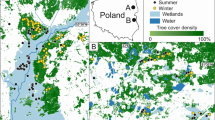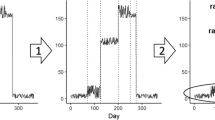Abstract
Ungulate habitat use and movements are highly variable among individuals, populations, and regions. Factors that influence annual and seasonal movements are important to understand for management purposes. Within some populations, moose (Alces alces) are known to migrate between seasonal ranges, generally in response to changes in the environment. A total of 45 female moose were fitted with GPS collars between March 1, 2014, and February 28, 2018, in and around the John Prince Research Forest in north-central British Columbia, Canada, to determine the prevalence and timing of migration. Using the model-based net squared displacement approach, we classified 67 (74%) annual trajectories as migratory, of which 43 (48%) were migrant and 24 (27%) were mix-migrant. We classified 22 annual trajectories (24%) as resident and one (1%) as a disperser. Moose with migratory trajectories exhibited a consistent pattern of leaving their winter range (WR) in April and returning from November to February after spending the majority of the year in their non-winter range (NWR). There was a significant negative correlation between mean monthly elevation and mean monthly snow on the ground for migratory moose. The mean distance separating migratory moose WR and NWR ranges (δ) was 32 km (SD = 30 km) but varied greatly from a minimum of 5 km to a maximum of 61 km. We discuss the potential implications of our results on surveys used to estimate moose population abundance and trends. We contend that a better understanding of moose seasonal habitat use patterns would aid moose management, help delineate important seasonal rangelands and migration corridors, inform population survey designs, and expand our understanding of moose populations in general.



Similar content being viewed by others
Data availability
The data associated with this manuscript are part of a larger project in partnership with the Government of British Columbia.
Code availability
Not applicable.
References
Andersen R (1991) Habitat deterioration and the migratory behaviour of moose (Alces alces L.) in Norway. J Appl Ecol 28:102–108
Anderson M, McLellan B, Serrouya R (2018) Moose response to high-elevation forestry: implications for apparent competition with endangered caribou. J Wildl Manage 82:299–309
Ball JP et al (2001) Partial migration by large ungulates: characteristics of seasonal moose Alces alces ranges in northern Sweden. Wildl Biol 7:39–47
Berg JE et al (2019) Prevalence and mechanisms of partial migration in ungulates. Front Ecol Evol 7:325. https://doi.org/10.3389/fevo.2019.00325
Borowik T et al (2020) The level of habitat patchiness influences movement strategy of moose in Eastern Poland. PLoS ONE 15(3):e0230521. https://doi.org/10.1371/journal.pone.0230521
Brown JS et al (1999) The ecology of fear: optimal foraging, game theory, and trophic interactions. J Mammal 80:385–399
Bunnefeld N et al (2011) A model-driven approach to quantify migration patterns: individual, regional and yearly differences. J Anim Ecol 80:466–476
Burnham and Anderson (2002) Model selection and inference: a practical information theoretic approach, 2nd edn. Springer-Verlag, New York
Cadsand B et al (2012) Moose density and composition in the Southern Omineca Region, winter 2011–2012. Ministry of Forests, Lands, Natural Resource Operations, Prince George, BC.
Cagnacci F et al (2011) Partial migration in roe deer: migratory and resident tactics are end points of a behavioural gradient determined by ecological factors. Oikos 120:1790–1802
Demarchi MW (2003) Migratory patterns and home range size of moose in the central Nass Valley. British Columbia Northwest Nat 84:135
Dingle H, Drake VA (2007) What is migration? Bioscience 57:113–121
Edwards RY, Ritcey RW (1956) The migrations of a moose herd. J Mammal 37:486
Emlen JM (1966) The role of time and energy in food preference. Am Nat 100:611–617
Environment and Climate Change Canada (2018). Canadian climate normals 1981–2010 station data. Downloaded from https://climate.weather.gc.ca/climate_normals/index_e.html.
Environment and Climate Change Canada (2019). Historical data - climate. Downloaded from https://climate.weather.gc.ca/historical_data/search_historic_data_e.html.
Ericsson G et al (1999) Climate change, moose and their human predators. Ecol Bull 47:178–187
Fancy SG et al (1989) Seasonal movements of caribou in arctic Alaska as determined by satellite. Can j Zool 67:644–650
Fieberg J et al (2008) Understanding variation in autumn migration of northern white-tailed deer by long-term study. J Mammal 89:1529–1539
Fisher RA (1925) Statistical methods for research workers. Oliver and Boyd.
Gaidet N, Lecomte P (2013) Benefits of migration in a partially-migratory tropical ungulate. BMC Ecol 13:36–36
Gillingham MP, Parker KL (2008) Differential habitat selection by moose and elk in the Besa-Prophet area of Northern British Columbia. Alces 44:41–63
Hatter J (1950) The moose of Central British Columbia. Unpublished doctoral dissertation, Washington State University, Pullman, WA.
Hebblewhite M, Merrill EH (2009) Trade-offs between predation risk and forage differ between migrant strategies in a migratory ungulate. Ecology 90:3445–3454
Klaczek M, Marshall S, Batho A., Anderson M (2017) Density and composition of moose (Alces alces) within the Southern Omineca Region, central British Columbia. Winter 2016–2017. British Columbia Ministry of Forests, Lands and Natural Resource Operations, Prince George, BC.
Kuzyk G (2016) Provincial population and harvest estimates of moose in British Columbia. Alces 52:1–11
Kuzyk G, Heard D (2014) Research design to determine factors affecting moose population change in British Columbia: testing the landscape change hypothesis. Minist For Lands Nat Resour Wildl Bull 126:1–16
Kuzyk G et al (2018) Determining factors affecting moose population change in British Columbia: testing the landscape change hypothesis. 2018 Progress Report: February 2012–April 2018. B.C. Minist. For., Lands and Nat. Resour. Operations and Rural Dev. Victoria, BC. Wildl. Working Rep. No. WR-126. Pp. 64.
Laundré JW et al (2001) Wolves, elk, and bison: reestablishing the “landscape of fear” in Yellowstone National Park, U.S.A. Can j Zool 79:1401–1409
Leblond M et al (2010) What drives fine-scale movements of large herbivores? A case study using moose. Ecography 33:1102–1112
Lendrum PE, Anderson CR, Monteith KL, Jenks JA, Bowyer RT, Ovadia O (2013) Migrating mule deer: effects of anthropogenically altered landscapes. PLoS ONE 8(5):e64548
Lendrum PE et al (2014) Relating the movement of a rapidly migrating ungulate to spatiotemporal patterns of forage quality. Mamm Biol 79:369–375
Lundmark C, Ball JP (2008) Living in snowy environments: quantifying the influence of snow on moose behavior. Arct Antarct Alp Res 40:111–118
MacArthur RH, Pianka ER (1966) On optimal use of a patchy environment. Am Nat 100:603–609
Meidinger D, Pojar J (Eds.) (1991) Ecosystems of British Columbia. Special Report Series 6, Victoria, BC. B.C. Ministry of Forests and Range Research Branch.
Meisingset EL et al (2018) Spatial mismatch between management units and movement ecology of a partially migratory ungulate. J Appl Ecol 55:745–753
Merkle JA et al (2016) Large herbivores surf waves of green-up during spring. Proc. R. Soc. B.28320160456.
Mose VN et al (2013) Modelling the dynamics of migrations for large herbivore populations in the Amboseli National Park. Kenya Ecol Model 254:43–49
Mueller et al (2011) How landscape dynamics link individual- to population-level movement patterns: a multispecies comparison of ungulate relocation data. Glob Ecol Biogeogr 20:683–694
Mysterud A (2013) Ungulate migration, plant phenology, and large carnivores: the times they are a-changin’. Ecology 94:1257–1261
Nicholson KL et al (2016) Modeling caribou movements: seasonal ranges and migration routes of the Central Arctic herd. PLoS ONE 11:e0150333–e0150333
Parker KL et al (1984) Energy expenditures for locomotion by mule deer and elk. J Wildl Manag 48:474–488
Pennycuick L (1975) Movements of the migratory wildebeest population in the Serengeti area between 1960 and 1973. Afr j Ecol 13:65–87
Peters W et al (2019) Large herbivore migration plasticity along environmental gradients in Europe: life-history traits modulate forage effects. Oikos 128:416–429
Poole KG et al (2007) Moose calving strategies in interior montane ecosystems. J Mammal 88:139–150
Poole KG, Stuart-Smith K (2006) Winter habitat selection by female moose in western interior montane forests. Can j Zool 84:1823–1832
Rea RV et al (2019) Scat analysis as a preliminary assessment of moose calf consumption by bears (Ursus spp.) in north–central British Columbia. Anim Biodivers Conserv 42(2):369–377. https://doi.org/10.32800/abc.2019.42.0369
Rivrud IM et al (2019) Future suitability of habitat in a migratory ungulate under climate change. Proc R Soc 286:1899. https://doi.org/10.1098/rspb.2019.0442
Rolandsen CM et al (2017) On fitness and partial migration in a large herbivore – migratory moose have higher reproductive performance than residents. Oikos 126:547–555
Safronov VM (2009) Regional populations and migration of moose in Northern Yakutia, Russia. Alces 45:17–20
Santomauro D et al (2012) Historical-ecological evaluation of the long-term distribution of woodland caribou and moose in central British Columbia. Ecosphere 3:37
Sawyer H et al (2016) The extra mile: ungulate migration distance alters the use of seasonal range and exposure to anthropogenic risk. Ecosphere 7:e01534
Schnorbus M et al (2012) Impacts of climate change in three hydrologic regimes in British Columbia. Canada Hydrol Process 28:1170–1189
Serrouya R, McLellan BN, van Oort H, Mowat G, Boutin S (2017) Experimental moose reduction lowers wolf density and stops decline of endangered caribou. PeerJ 5:e3736. https://doi.org/10.7717/peerj.3736
Shrestha R et al (2012) Modelling spatial and temporal variability of hydrologic impacts of climate change in the Fraser River basin, British Columbia. Canada Hydrol Process 26:1840–1860
Singh NJ et al (2010) Tracking greenery across a latitudinal gradient in central Asia – the migration of the saiga antelope. Divers Distrib 16:663–675
Singh NJ et al (2012) From migration to nomadism: movement variability in a northern ungulate across its latitudinal range. Ecol Appl 22:2007–2020
Singh NJ et al (2016) Quantifying migration behaviour using net squared displacement approach: clarifications and caveats. PLoS ONE 11:e0149594
Spitz D, Hebblewhite M, Stephenson T (2017) ‘MigrateR’ extending model driven methods for classifying and quantifying animal movement behavior. Ecography 40:788–799
Sweanor PY, Sandegren F (1989) Winter-range philopatry of seasonally migratory moose. J Appl Ecol 26:25–33
van Moorter B et al (2016) Movement is the glue connecting home ranges and habitat selection. J Anim Ecol 85:21–31
White PJ et al (2007) Partial migration and philopatry of Yellowstone pronghorn. Biol Conserv 135:502–510
White KS et al (2014) Benefits of migration in relation to nutritional condition and predation risk in a partially migratory moose population. Ecology 95:225–237
Wilcoxon F (1945) Individual comparisons by ranking methods. Biom Bull 1:80–83
Acknowledgements
The authors would like to thank the Tl’azt’en Nation and Nak’azdli Whut’en Nation for their support for the project. Thanks to Douglas Heard, Gerald Kuzyk, Glen Watts, Ralph Pierre, Beverly John, and Fred Sam for help getting the project started. We thank Glen Watts, Greg Altoft, David Argument, Brad Culling, Mike Klazek, Rob Altoft, and Bryan Macbeth for capture assistance.
Funding
Funding was provided by the Government of British Columbia, John Prince Research Forest, Tanizul Timber Ltd, TransCanada Corp, Spectra Energy, and Cliffs Natural Resources.
Author information
Authors and Affiliations
Corresponding author
Ethics declarations
Ethics approval
Research ethics and capture permit were obtained under the British Columbia Wildlife Act (#PG13-92390).
Consent to participate
Not applicable.
Consent for publication
Not applicable.
Conflicts of interest
The authors declare no competing interests.
Additional information
Communicated by Rafał Kowalczyk
Publisher’s note
Springer Nature remains neutral with regard to jurisdictional claims in published maps and institutional affiliations.
Supplementary Information
Below is the link to the electronic supplementary material.
Rights and permissions
About this article
Cite this article
Chisholm, J.D., Hodder, D.P., Crowley, S.M. et al. Seasonal movements of migratory and resident female moose (Alces alces) in north-central British Columbia, Canada. Mamm Res 66, 419–427 (2021). https://doi.org/10.1007/s13364-021-00575-6
Received:
Accepted:
Published:
Issue Date:
DOI: https://doi.org/10.1007/s13364-021-00575-6




